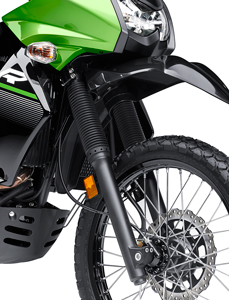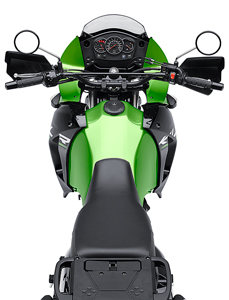The picture and article below "
PROJECT RECYCLE - KAWASAKI KLR650" come from the
cycleworld.com website and is a common web article for the KLR650. Once again, they bought a KLR project bike, put in a plug for Bike Bandit, then bolted on a lot of aftermarket accessories. As usual, when finished the KLR is a much better bike. A KLR veteran may take interest in these mods but, a KLR noob or a wanna be may have an entirely different view. This sort of article could scare the crap out of that person.
Who wants to buy a bike that needs this many upgrades, that cost several hundred additional dollars? The article does not say if these mods are "essential" or just "nice to have." (I would put lowered handlebars in the "nice to have" category.)
KLR noobs and wanna bes - relax! This article has good info on some aftermarket parts but, the stock bike runs and handles fine. Yes, it can be improved but, there's no need to immediately dump a wad of cash into your new ride to enjoy it. Go ahead and read the article below, but don't let it scare you. KLR riders have nothing to fear, but fear itself!
PROJECT RECYCLE - KAWASAKI KLR650
In many ways, the Kawasaki KLR650 is the default choice for a lightweight, low-cost adventure machine. It’s been around since 1987 and remained almost unchanged through 2007, and along the way, it has introduced hundreds—heck, maybe even thousands of riders to the joys and capabilities the big Thumper has to offer.
For us, as part of the Re-Cycle program, the KLR’s sheer numbers were motivation enough. Incredibly well-supported in the aftermarket, the KLR would not be difficult to update and improve; thousands of owners got there well ahead of us. Moreover, the weaker aspects of its design—mostly the result of it hailing from the mid-1980s—were well known. So, we followed the herd and applied the better-known modifications and updates.
The bike you see here, a 2006 model, was found in the Los Angeles area in near-pristine shape, with fewer than 3000 miles on the odometer. Except for an aftermarket exhaust and minor rejetting, it was mechanically stock. It wore a pair of dirt-oriented tires that had suffered from too many miles on the street, but both functionally and cosmetically, the bike was near-new.
We paid $3700 for our KLR, which—based on its clean, unmolested condition—is slightly above the market value. In our search, we found bikes from nearly new ones priced at around $4000 to some high-mileage units we could have grabbed for $2000. Bang for the buck? You bet!
And now, with the help of
BikeBandit.com’s extensive catalog, this KLR is better than ever.
ENGINE AND DRIVETRAIN
Kawasaki’s 651cc dohc Single is what you’d call proven, though that also means every Internet Joe with wi-fi has shared his troubles with the world. If you’re a wanna-be KLR owner, Google “doohickey mod” to learn about a common issue with the engine’s counterbalancer chain tensioner, as one example.
Instead of opening up the engine and fitting a big-bore kit (a popular update for both new and tired KLRs), we attacked the usual means, swapping the 11-pound stock exhaust for a Yoshimura RS-2 slip-on muffler with spark arrestor and shiny stainless-steel lead-in pipe—it’s a beautiful thing, though we had to do a little fender trimming and sidecover shimming to make it fit.
On the front side, a K&N stock-replacement filter and a Dynojet Stage I jet kit did the deed. According to the dyno
chart that came with the Yoshimura pipe, some 3-4 hp are available from stock. We didn’t dyno this particular KLR before the mods, so true A-to-B comparisons aren’t possible. But if we get the promised 37 hp, we’ll be happy enough. Right out of the box, this combination worked very well, with smooth throttle response, no surging and only a slight amount of cold-bloodedness.
KLR owners often ask for a sixth transmission speed, but lacking that, we attempted a compromise in gearing, wrapping a new D.I.D 520V O-ring chain around a pair of JT sprockets, in the stock 15-tooth size at the countershaft and down one (42 teeth) at the rear. This change took the edge off the KLR’s frantic highway demeanor, though it could handle a 40- or 41-tooth rear if you were willing to slide your street/dirt ratio over to, say, 90/10.
SUSPENSION AND TIRES
You might expect any KLR with a few more digits showing in its retro odometer to have soft legs, and you’d be right. The standard KLR shock, not exactly a high-tech item, is adjustable for spring preload only, and the 38mm KYB fork has no adjustments other than air pressure for spring rate (remember that?). Our efforts to improve suspension action without breaking the bank called on
Progressive Suspension for its new 465 series shock—an aluminum-bodied beauty with stepless spring preload and five-way rebounding-damping adjustment. Up front, a Race Tech Cartridge Emulator was dropped down the skinny tubes—after the usual prep work, of course—topped by RT springs rated at 0.52 kg/mm, up from the stock rate of 0.4, running 15mm of preload. We left the Emulator settings as delivered, filled the legs with 15-weight oil so there was 150mm of air space.
On the road, the Re-Cycle KLR’s composure is dramatically improved. Increased spring rates help reduce the stock bike’s hobby-horsing without harming small-bump compliance; in fact, the revised KLR’s ride is better all around.
Another means of updating our KLR, which arrived with dirt-spec Dunlops that rendered the steering strange and howled on pavement, came from Metzeler in the form of Tourance tires.
In stock sizes—90/90-21 front and 130/90-17 rear—the street-biased Tourances provide as much grip as the KLR’s chassis ever wants and are even passable away from pavement, as long as your definition of off-road doesn’t include sand bogs or boulder-strewn goat trails. Let’s remember what the KLR isn’t: a lightweight, modern-suspension trail runner.
BRAKES
Kawasaki, known for eking every single solitary development cent from components, continued to give the KLR650 a single-piston, sliding-pin caliper dating from the days before the GPz. We did what we could, fitting Galfer semi-metallic pads front and rear, along with Galfer braided-steel lines.
No question the lever and pedal are firmer than stock, but the front brake’s power remains underwhelming. Next steps would include a different caliper and a larger rotor, but that’s starting to get into real money. Besides, you have to wonder how much brake that limber fork will tolerate; it twists enough during hard stops as it is.
ERGONOMICS
Next on the list was to update the KLR’s ergonomics. Those steel handlebars might as well date from the early Malcolm Smith period, so after perusing BikeBandit.com’s virtual catalog a set of Renthal CR-Low bars were selected and fitted. They are 1 inch narrower and 2.5 inches lower than stock, with half the weight. They’re about the lowest you’ll get to fit; the switch clusters just clear the tank at full steering lock. The ends are fitted with Show Chrome heated grips, which come with a digital, four-level heat controller and a full wiring harness.
For the rest of the rider’s physique, we have a Sargent World Sport Performance replacement seat that fits the KLR perfectly and is such an incredible improvement over the stocker that it should be the first update you make. We also replaced the slippery stock footpegs with a set of IMS Super Stock pegs that are suitably saw-toothed and deeper.
LUGGAGE RACKS
One benefit of choosing a long-running model like the KLR650 is that the aftermarket will have a wide selection of accessories, particularly luggage. Here we called on a strong seller in the BikeBandit.com family: Moose Racing. Moose provided its Expedition luggage rack system. This steel-tube affair, powdercoated black, slipped onto the KLR without trouble, replacing the stock luggage rack and providing sturdy perches for genuine Pelican hard bags. They’re a good size for the KLR, too, at 21.4 inches wide, 12.8 inches tall and 6.7 inches deep. Mounted, the bags are slightly wider than the new bars, so be careful in traffic.







































